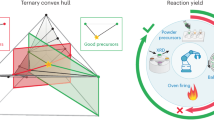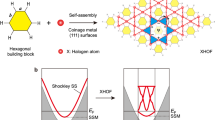Abstract
The nucleation and growth of solids from solutions impacts many natural processes and is fundamental to applications in materials engineering and medicine. For a crystalline solid, the nucleus is a nanoscale cluster of ordered atoms that forms through mechanisms still poorly understood. In particular, it is unclear whether a nucleus forms spontaneously from solution via a single- or multiple-step process. Here, using in situ electron microscopy, we show how gold and silver nanocrystals nucleate from supersaturated aqueous solutions in three distinct steps: spinodal decomposition into solute-rich and solute-poor liquid phases, nucleation of amorphous nanoclusters within the metal-rich liquid phase, followed by crystallization of these amorphous clusters. Our ab initio calculations on gold nucleation suggest that these steps might be associated with strong gold–gold atom coupling and water-mediated metastable gold complexes. The understanding of intermediate steps in nuclei formation has important implications for the formation and growth of both crystalline and amorphous materials.
This is a preview of subscription content, access via your institution
Access options
Subscribe to this journal
Receive 12 print issues and online access
$259.00 per year
only $21.58 per issue
Buy this article
- Purchase on Springer Link
- Instant access to full article PDF
Prices may be subject to local taxes which are calculated during checkout




Similar content being viewed by others
References
Sear, R. P. The non-classical nucleation of crystals: microscopic mechanisms and applications to molecular crystals, ice and calcium carbonate. Int. Mater. Rev. 57, 328–356 (2012).
De Yoreo, J. J. & Vekilov, P. G. in Biomineralization (eds Dove, P., De Yoreo, J. & Weiner, S.) 57–93 (Mineralogical Society of America, 2003).
Vekilov, P. G. Dense liquid precursor for the nucleation of ordered solid phases from solution. Cryst. Growth Des. 4, 671–685 (2004).
Kalikmanov, V. I. Nucleation Theory (Lecture Notes in Physics Vol. 860, Springer, 2013).
De Yoreo, J. J. et al. Crystallization by particle attachment in synthetic, biogenic, and geologic environments. Science 349, aaa6760 (2015).
Hill, P. G. Condensation of water vapour during supersonic expansion in nozzles. J. Fluid Mech. 25, 593–620 (1966).
Vekilov, P. G. The two-step mechanism of nucleation of crystals in solution. Nanoscale 2, 2346–2357 (2010).
Sanz, E. et al. Homogeneous ice nucleation at moderate supercooling from molecular simulation. J. Am. Chem. Soc. 135, 15008–15017 (2013).
De Yoreo, J. Crystal nucleation: more than one pathway. Nat. Mater. 12, 284–285 (2013).
Erdemir, D., Lee, A. Y. & Myerson, A. S. Nucleation of crystals from solution: classical and two-step models. Acc. Chem. Res. 42, 621–629 (2009).
Cahn, J. W. & Hilliard, J. E. Free energy of a nonuniform system. III. Nucleation in a two-component incompressible fluid. J. Chem. Phys. 31, 688–699 (1959).
Wallace, A. F. et al. Microscopic evidence for liquid–liquid separation in supersaturated CaCO3 solutions. Science 341, 885–889 (2013).
Nielsen, M. H., Aloni, S. & De Yoreo, J. J. In situ TEM imaging of CaCO3 nucleation reveals coexistence of direct and indirect pathways. Science 345, 1158–1162 (2014).
Vekilov, P. G. Phase diagrams and kinetics of phase transitions in protein solutions. J. Phys. Condens. Matter 24, 193101 (2012).
Zheng, H. et al. Observation of single colloidal platinum nanocrystal growth trajectories. Science 324, 1309–1312 (2009).
Woehl, T. J., Evans, J. E., Arslan, I., Ristenpart, W. D. & Browning, N. D. Direct in situ determination of the mechanisms controlling nanoparticle nucleation and growth. ACS Nano 6, 8599–8610 (2012).
Patterson, J. P. et al. Observing the growth of metal–organic frameworks by in situ liquid cell transmission electron microscopy. J. Am. Chem. Soc. 137, 7322–7328 (2015).
Tromp, R. M. & Ross, F. M. Advances in in situ ultra-high vacuum electron microscopy growth of SiGe on Si. Annu. Rev. Mater. Sci. 30, 431–449 (2000).
Privman, V., Goia, D. V., Park, J. & Matijevic, E. Mechanism of formation of monodispersed colloids by aggregation of nanosize precursors. J. Colloid Interface Sci. 213, 36–45 (1999).
Mikhlin, Y. et al. Submicrometer intermediates in the citrate synthesis of gold nanoparticles: new insights into the nucleation and crystal growth mechanisms. J. Colloid Interface Sci. 362, 330–336 (2011).
Sambles, J. R. An electron microscope study of evaporating gold particles: the Kelvin equation for liquid gold and the lowering of the melting point of solid gold particles. Proc. R. Soc. Lond. A. 324, 339–351 (1971).
Chushak, Y. G. & Bartell, L. S. Melting and freezing of gold nanoclusters. J. Phys. Chem. B 105, 11605–11614 (2001).
Gachard, E. et al. Radiation-induced and chemical formation of gold clusters. New J. Chem. 22, 1257–1265 (1998).
Xin, H. L. & Zheng, H. In situ observation of oscillatory growth of bismuth nanoparticles. Nano Lett. 12, 1470–1474 (2012).
Aabdin, Z. et al. Bonding pathways of gold nanocrystals in solution. Nano Lett. 14, 6639–6643 (2014).
Lu, J., Aabdin, Z., Loh, N. D., Bhattacharya, D. & Mirsaidov, U. Nanoparticle dynamics in a nanodroplet. Nano Lett. 14, 2111–2115 (2014).
Park, J. et al. 3D structure of individual nanocrystals in solution by electron microscopy. Science 349, 290–295 (2015).
Seidell, A. & Linke, W. F. Solubilities of Inorganic and Metal–Organic Compounds (Van Nostrand, 1958).
Laughlin, D. E. & Soffa, W. Spinodal structures. ASM Handbook 9, 652–654 (1985).
Dey, G. R., El Omar, A. K., Jacob, J. A., Mostafavi, M. & Belloni, J. Mechanism of trivalent gold reduction and reactivity of transient divalent and monovalent gold ions studied by gamma and pulse radiolysis. J. Phys. Chem. A 115, 383–391 (2011).
Rappl, T. J. & Balsara, N. P. Does coarsening begin during the initial stages of spinodal decomposition? J. Chem. Phys. 122, 22–25 (2005).
Guenther, G. & Guillon, O. Models of size-dependent nanoparticle melting tested on gold. J. Mater. Sci. 49, 7915–7932 (2014).
Gruene, P. et al. Structures of neutral Au7, Au19, and Au20 clusters in the gas phase. Science 321, 674–676 (2008).
Li, L. et al. Noncrystalline-to-crystalline transformations in Pt nanoparticles. J. Am. Chem. Soc. 135, 13062–13072 (2013).
Belloni, J. Nucleation, growth and properties of nanoclusters studied by radiation chemistry application to catalysis. Catal. Today 113, 141–156 (2006).
Williamson, M. J., Tromp, R. M., Vereecken, P. M., Hull, R. & Ross, F. M. Dynamic microscopy of nanoscale cluster growth at the solid–liquid interface. Nat. Mater. 2, 532–536 (2003).
Ross, F. M. Opportunities and challenges in liquid cell electron microscopy. Science 350, aaa9886 (2015).
Mirsaidov, U. M., Zheng, H., Bhattacharya, D., Casana, Y. & Matsudaira, P. Direct observation of stick-slip movements of water nanodroplets induced by an electron beam. Proc. Natl Acad. Sci. USA 109, 7187–7190 (2012).
Acknowledgements
This work was supported by the Singapore National Research Foundation's Competitive Research Program funding (NRF-CRP9-2011-04) and the Young Investigator Award (NUSYIA-FY14-P17) from the National University of Singapore. C.A.N. and M.B. acknowledge support from grant No. NRF-CRP8-2011-07, U.M. and P.M. acknowledges support from the Microbiology Institute (Singapore) and the Centre for Bioimaging Sciences. N.D.L. thanks the support of the Lee Kuan Yew Endowment Fund, and National University of Singapore internal grant No. 154-000-606-112. The work of P.K. was supported by the National Science Foundation Division of Materials Research Grant No. 1309765 and by the American Chemical Society Petroleum Research Funding Grant No. 53062-ND6.
Author information
Authors and Affiliations
Contributions
U.M. and P.M. conceived the study. U.M. designed the in situ experiments, which he performed together with M.B. and S.F.T.; N.D.L. designed and implemented the image processing and statistical analysis on the TEM images, with help from J.Z. and input from U.M., P.M., C.A.N. and M.B.; N.D.L. did and, with U.M. and M.B., wrote up the analyses in the Supplementary Information on CNT, spinodal decomposition and the effects of the electron beam. S.S. and P.K. carried out the hybrid molecular dynamics calculations. N.D.L., C.A.N., P.K., P.M. and U.M. wrote the manuscript from discussions that arose from all authors.
Corresponding authors
Ethics declarations
Competing interests
The authors declare no competing financial interests.
Supplementary information
Supplementary information
Supplementary information (PDF 4709 kb)
Supplementary information
Supplementary Movie 1 (MOV 4220 kb)
Supplementary information
Supplementary Movie 2 (MOV 13572 kb)
Supplementary information
Supplementary Movie 3 (MOV 6612 kb)
Rights and permissions
About this article
Cite this article
Loh, N., Sen, S., Bosman, M. et al. Multistep nucleation of nanocrystals in aqueous solution. Nature Chem 9, 77–82 (2017). https://doi.org/10.1038/nchem.2618
Received:
Accepted:
Published:
Issue Date:
DOI: https://doi.org/10.1038/nchem.2618
This article is cited by
-
Impact of molecular symmetry on crystallization pathways in highly supersaturated KH2PO4 solutions
Nature Communications (2024)
-
Lithium crystallization at solid interfaces
Nature Communications (2023)
-
Microfluidic investigation of pore-size dependency of barite nucleation
Communications Chemistry (2023)
-
Near-infrared-IIb emitting single-atom catalyst for imaging-guided therapy of blood-brain barrier breakdown after traumatic brain injury
Nature Communications (2023)
-
One droplet reaction for synthesis of multi-sized nanoparticles
Nano Research (2023)



